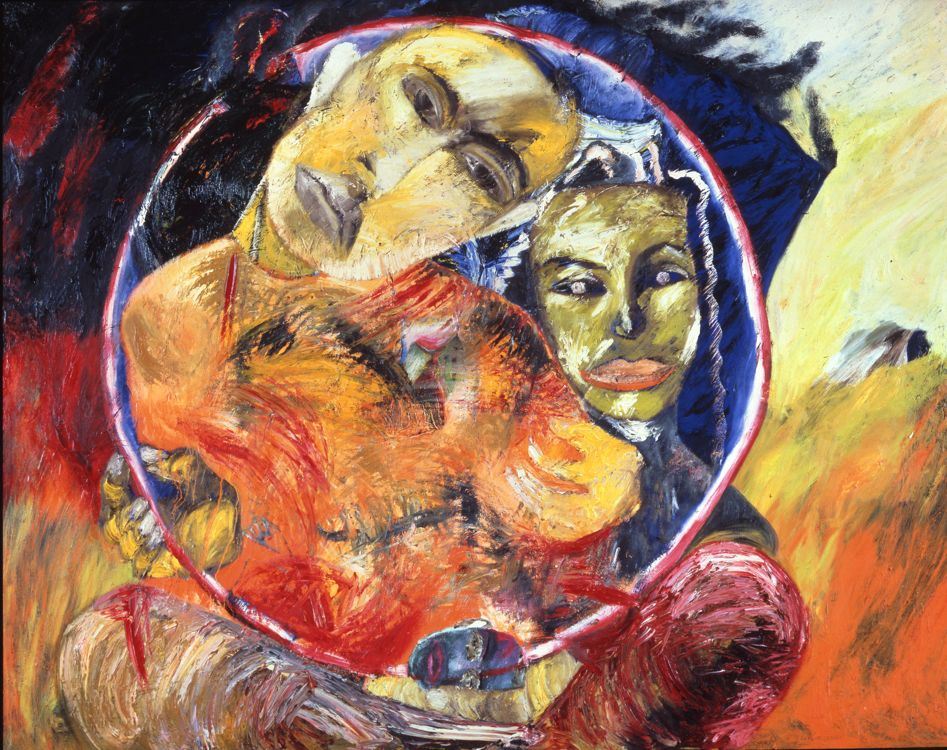Francesco Clemente
Francesco Clemente focuses on the visual arts, which are informed by his interest in music, poetry, and literature. He freely uses a variety of mediums equally, following his inclinations as they arise or the demands of an image. His watercolors, pastels, oil paintings, drawings, frescoes, and mosaics describe a world in a constant state of becoming in perpetual change. His works connect to his many travels; they convey the voices and cultural traditions of distant lands and interweave them with the artist’s personal biography.
Clemente moved to Rome from his hometown of Naples in the 1970s to enroll in the architecture school. There, he met the artists Alighiero Boetti, Luigi Ontani, and Cy Twombly, whose painting, rich in signs and lines, made a profound impression on him. During the following decade he lived in New York, where he came into contact with that city’s lively cultural life. In this same period he travelled through India, where he has repeatedly returned for lengthy stays. His immersion in Indian and East Asian traditions have been a constant source of inspiration for a body of work that is dense with complex iconographic references, and for the private, diaristic sensibility that characterizes many of the pieces. Embracing drawing and then painting, he has gradually developed an intensely personal, subjective language. Creating works that seem to exist in a state of constant equilibrium between a narrative and an imaginative dimension, the human figure is always central to his interests. The body as a boundary that divides interior from exterior becomes a tool for the artist to both delving into an inner self and register an awareness of the surrounding reality.
From the beginning of his career, the artist has focused on the theme of the self-portrait. In these works he often appears with his eyes greatly enlarged or his body subjected to distortions and deformations. In Autoritratto senza specchio (Self-Portrait without Mirror), 1979, the contorted position of the legs and arms represents a modality for confronting the world from another angle. It is a way to observe the self and others from different, unusual perspectives—a sort of documentation of the ego, whose continuous repetition does not define fragmentation or dispersion, but represents new birth. In this, as in other drawings, Clemente’s open style heightens the value of relationships and assonances, combinatory plays and visual analogies, ideograms and free imagination. Clemente expands his natural inclination for the fragment, opening up his visual expression to the potentials of line. His poetic imagination swarms with fragments of bodies, emotions impressed onto paper or canvas, complex or extremely simple and stylized forms, sections of time and space, gaps and fragilities, which populate the surface of his works.
Images mingle and merge, become reanimated without precise significance, without resorting to conceptual interpretations, but rather presenting themselves for the pleasure of viewing, in the space of the surface that contains them. Through a process of continuous metamorphosis and change, forms transmigrate and abandon the cultural context to which they pertain, to be represented in a different manner, in another corner of the world.
From June to September 1982, Clemente painted Il cerchio di Milarepa (Milarepa’s Circle–previously published under the title The Midnight Sun IX ). The work belongs to a series of twelve canvases, conceived as a replica of another group of paintings, The Fourteen Stations, and was created during a period spent in Capri. The subject was inspired by East Asian tradition, and the suggestion of a figure of a Buddhist monk who devotes his entire existence to the search for enlightenment is borne out in the dense material surface, formed from many pictorial layers. In the stratification of images without any specific interest, but with only a joy in encountering each other, we can interpret the multiple and extenuating trials to which the hermit was subjected during his life on earth.
Francesco Clemente’s pictorial context is nurtured by free invention; it is borderline painting, art that embraces past and present, West and East. His intimately autobiographical work describes voyages and gives voice to his deepest self, nurtured by his life and by his personal experiences.
[GC]

